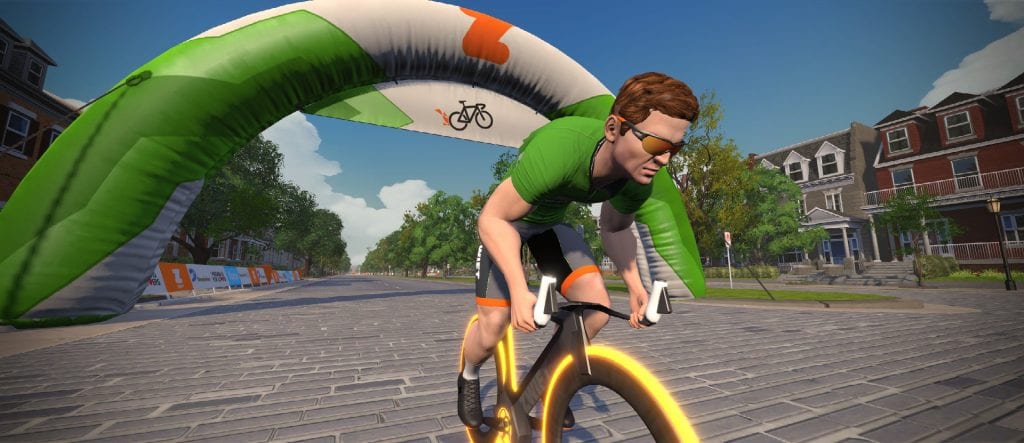Most Zwift races come down to a pack sprint, and many of those sprints are won by a half-second or less. Because of this, smart racers would be well-served to understand how powerups and equipment selection influence their sprint times.
We’ve recently run a bevy of tests to learn how variations in rider weight, height, power, powerups, and frame/wheel choice affect sprint times. We’ve summarized the findings of these results below, but if you’d like to dig into the raw timing data you can do so on this Google sheet, under the “Sprints (Richmond)” tab.
Methodology
We ran a series of test sprints on Richmond’s Monument Avenue forward sprint segment. We selected this sprint because the road is quite flat, straight, and the sprint lasts approximately 15 seconds, so our powerups can run for the length of the sprint.
Our tests were run in isolation (no drafting other riders) at various rider weights, heights, and steady-state wattages. We also tested various frames and wheelsets. Unless stated, test results shown below are from a 75kg, 183cm male rider holding 750 watts.
Our rider held the set wattage for at least a few kilometers leading into the sprint to ensure that acceleration from wattage changes did not affect sprint times. When powerups were being tested, we activated them at the sprint start line so they would run for the entire length of the sprint. (While this may not be what happens in a race situation, it was the most repeatable methodology for the purpose of these tests.)


Aero Powerup Advantage
The aero powerup improves sprint times significantly, which explains why it’s the most coveted powerup for a race finish!
The amount of time saved by the aero powerup decreases slightly as wattage (and therefore speed) increases:
- 900 watts (12 w/kg): 0.56 seconds faster
- 750 watts (10 w/kg): 0.60 seconds faster
- 600 watts (8 w/kg): 0.63 seconds faster
The time saved by using the aero powerup in a sprint is quite consistent across different combinations of frames and wheelsets, varying 0.02 seconds or less between different frames/wheelsets.
Once we computed the time advantage of the aero powerup, we could attempt the sprints without an aero powerup, increasing the power to match the time delivered by the aero powerup. This tells us how much additional power you would need to hold to compete with a rider using the aero powerup. Or to put it another way, it tells us what the “wattage bonus” of the aero powerup is.
- 900 watts (12 w/kg): 115 watts
- 750 watts (10 w/kg): 100 watts
- 600 watts (8 w/kg): 80 watts
So the faster you’re going, the more of a wattage “bonus” the aero powerup offers.

Feather Powerup Advantage
The feather powerup improves sprint times consistently, regardless of which frame or wheelset you use:
- Felt AR with Zipp 858/Super9 wheels at 750 watts (10 w/kg): 0.17 seconds faster
- Specialized Venge S-Works with Zipp 858 wheels at 750 watts (10 w/kg): 0.18 seconds faster
- Trek Madone with Zipp 858 wheels at 750 watts (10 w/kg): 0.16 seconds faster
- Tron bike at 750 watts (10 w/kg): 0.16 seconds faster
- Zwift Carbon with 32mm Carbon wheels at 750 watts (10 w/kg): 0.17 seconds faster
The amount of time saved by the feather powerup varies when wattage varies, but not in a consistent way we can explain. Here are the results of our tests (repeated to make sure they’re correct):
- 900 watts (12 w/kg): 0.16 seconds faster
- 750 watts (10 w/kg): 0.16 seconds faster
- 600 watts (8 w/kg): 0.10 seconds faster
Rider Height
We already know height significantly affects speed in Zwift, since it is used to compute your virtual CdA. Our tests showed that, all other things being equal, every 10cm of height added results in a sprint which is 0.16-0.21 seconds slower:
- 203cm at 750 watts (10 w/kg): 14.66 seconds
- 193cm at 750 watts (10 w/kg): 14.5 seconds (0.16 seconds faster)
- 183cm at 750 watts (10 w/kg): 14.32 seconds (0.18 seconds faster)
- 173cm at 750 watts (10 w/kg): 14.13 seconds (0.19 seconds faster)
- 163cm at 750 watts (10 w/kg): 13.97 seconds (0.16 seconds faster)
- 153cm at 750 watts (10 w/kg): 13.76 seconds (0.21 seconds faster)
Frame and Wheelset Choice
Your frame and wheel choice affect sprint times, in approximately the same ratio as they affect times at normal race speeds. Therefore, our lists of fastest frames and fastest wheels also holds true for sprinting.
Examples:
- Upgrading from the 32mm carbon wheels to super-fast disc wheels will reduce your time in an hourlong flat race by approximately 1.71%. That same wheel swap will reduce your sprint time by 1.89%.
- Upgrading from the Zwift Carbon to the fast Felt AR will reduce your time in an hourlong flat race by approximately 0.55%. That same frame swap will reduce your sprint time by 0.41%.
Note: without more timing accuracy in-game and on Strava, it is difficult to determine if the percentage variances above are due to in-game physics or rounding.
Presumably due to rounding (Zwift only tracks sprint times to two decimal places), all of the wheels on our short fastest wheels list turn in the same sprint times, except for the three disc wheelsets, which turn in times .05 seconds faster. Similarly, the first four frames in our fastest frames list turn in essentially the same sprint times.
Therefore, your fastest sprint setups on flat ground will be (from fastest to slowest):
- Any of the first four frames in our fastest frames list, coupled with one of the disc wheelsets
- Tron (Concept Z1) bike (0.01-0.03 seconds slower than #1)
- Any of the first four frames in our fastest frames list, coupled one of the wheelsets on our fastest wheels list (0.01-0.02 seconds slower than #2)
By comparison, the base Zwift Carbon frame with 32mm wheels which every Zwifter begins with turns in a sprint time 0.33 seconds slower than #1 above.
Questions or Comments?
Post below!
